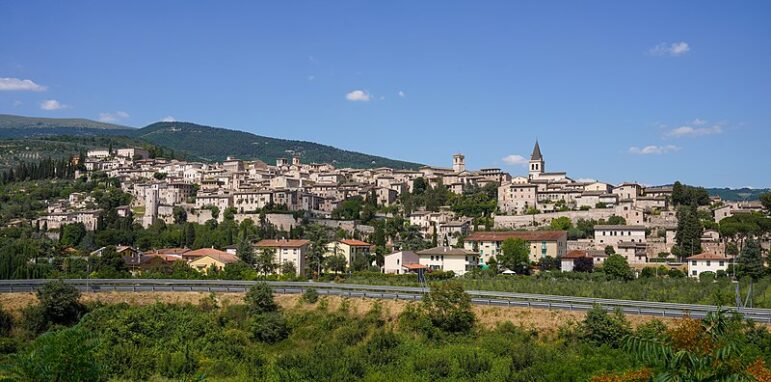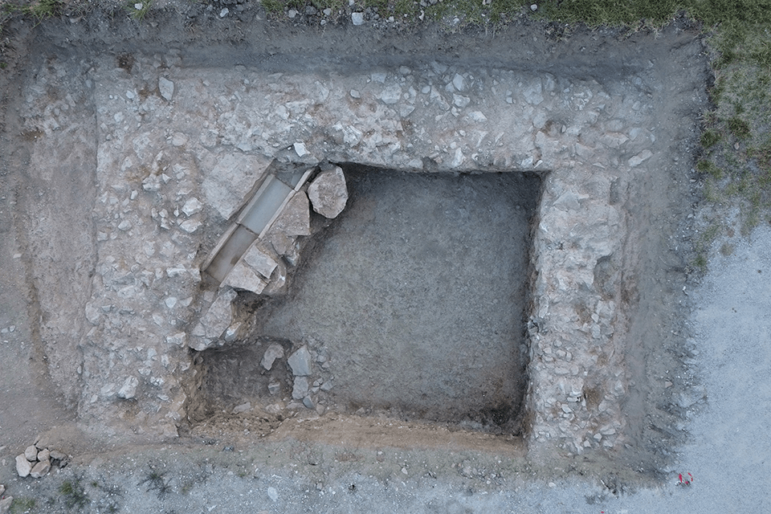
CHICAGO – The picturesque medieval hilltop town of Spello about 2.5 hours north of Rome in the Apennine Mountains has shared an ancient secret during a parking lot excavation. The factors that led to Rome embracing Christianity didn’t instantly turn the empire into a practitioner of contemporary Christianity. Despite the Christian revision of history, it was a gradual process.
During the annual meeting of the Archaeological Institute of America, Professor Douglas Boin, Ph.D., from Saint Louis University, raised eyebrows with a noteworthy revelation. He and his team unveiled their discovery of what they consider to be an ancient Roman temple, providing substantial insights into the societal shift from pagan deities to Christianity within the Roman Empire.

Panorama of Modern Spello [Photo Credit: WikiRomaWiki CCA-SA 4.0]
Dr. Boin chose the town by referring to a 4th-century letter from Emperor Constantine to the residents. The letter is a rescript, an authoritative decree issued by a Roman emperor in response to a specific request or question. It was a form of official communication where the emperor provided guidance or a decision on a particular matter. Rescripts covered various topics, including legal interpretations, administrative matters, and responses to petitions from individuals or communities. In this case. The rescript referenced instructions for a religious celebration.
The Constantinian Rescript was discovered some three hundred years ago in 1733 and is on display in Spello’s town hall. The Rescript permitted the residents of Spello to partake in a religious festival within their hometown, sparing them from the need to travel to a distant celebration. Nevertheless, the condition attached to this permission was the construction of a temple dedicated to Constantine’s divine ancestors, the Flavian family, requiring the townspeople to worship them.
Dr. Boin and his colleague, Dr. Letizia Ceccarelli, Politecnico di Milano, reviewed the Rescript and their team found the temple mentioned.
“We found three walls of a monumental structure that evidence suggests belonged to a Roman temple that dates to Constantine’s period,” Boin said. “It dates to the fourth century AD and if our team’s hypothesis is right, it will be a remarkable addition to the landscape of this corner of Italy. It will significantly aid in the understanding of the ancient town, the ancient townscape and city society in the later Roman Empire because it potentially shows the continuities between the classical pagan world and early Christian Roman world that often get blurred out or written out of the sweeping historical narratives.”
The temple shows the multicultural nature of Roman religious activity merging the pagan and Christian traditions. It also challenges the immediate conversion narrative about Constantine and the Roman Empire under his reign.
“There was a remarkable religious continuity between the Roman world and the early Christian World,” Dr. Boin stated. “Things didn’t change overnight. Before our find, we never had a sense that there were actual physical, religious sites associated with this late ‘imperial cult practice.’ But because of the inscription and its reference to a temple, Spello offered a very tantalizing potential for a major discovery of an Imperial cult underneath a Christian ruler.”
Boin added “There’s evidence from other places throughout the Roman world that Christian rulers supported imperial cult practices.”

“An aerial photo of what Douglas Boin, Ph.D., believes to be the inside walls of an Imperial Cult temple. This temple immediately became what Boin calls the largest evidence ever of the Imperial Cult in both fourth-century Italy and the late Roman Empire.” Photo Credit: Luca Primavesi, Spello Project.
He noted that previous sources had mentioned pagan worship in temples into Late Antiquity. “We’ve known that pagans worshiped at their temples in the fourth century, but those findings have all been small and inconsequential. And we’ve known that Christians supported the imperial cult, and we’ve known that without any sense of where it would have happened. This perceived temple would bridge those two landmarks, and in that respect, it is unlike any temple that I know about from the Mediterranean world of the fourth century Roman Empire. Any study of the imperial cult in the fourth century Roman Empire is now going to have to take account of this temple, which is an incredible discovery to make.”
Nevertheless, even with the discovery of three inner walls of a monumental structure, Boin remains cautious about the findings, underscoring the presence of many unknowns and anticipating further revelations. Planning to revisit Spello next summer, Boin and his team aim to conduct a thorough excavation of the area, delving into the ruins and exploring whatever lies beneath the soil, in the hope of making even more significant discoveries.
“We stand at the threshold of presenting compelling evidence that challenges conventional views of major cultural shifts, but there’s still much work ahead,” Boin stated. “Cultural changes, when experienced firsthand, are not as monumental as they may seem, and there exists a considerable gray area between people’s customs and the broader society and culture. Many nuances can be overlooked in the narrative. The potential of this temple being dedicated to Constantine’s divine ancestors, serving as a way to worship the emperor in an increasingly Christian world, is intriguingly peculiar, and I am excited about shedding more light on it. I eagerly anticipate uncovering further insights with our upcoming excavations.”
Even so, the temple challenges the earlier understanding of religious transition in Rome. “It will significantly aid in the understanding of the ancient town, the ancient townscape and city society in the later Roman Empire,” added Boin. “It shows the continuities between the classical pagan world and early Christian Roman world that often get blurred out or written out of the sweeping historical narratives.”
The Wild Hunt is not responsible for links to external content.
To join a conversation on this post:
Visit our The Wild Hunt subreddit! Point your favorite browser to https://www.reddit.com/r/The_Wild_Hunt_News/, then click “JOIN”. Make sure to click the bell, too, to be notified of new articles posted to our subreddit.
